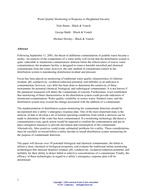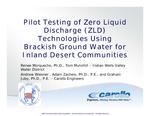Provide PDF Format
AWWA WQTC58802
- Water Quality Monitoring in Response to Heightened Security
- Conference Proceeding by American Water Works Association, 11/02/2003
- Publisher: AWWA
$12.00$24.00
Following September 11, 2001, the threat of deliberate contamination of potable water became areality. An analysis of the components of a water utility will reveal that the distribution system isquite vulnerable to intentional contamination. Dilution limits the effectiveness of source watercontamination, and the treatment facility is designed to remove harmful microbial and chemicalcontaminants from the water. However, the only method of contaminant control in thedistribution system is maintaining disinfectant residual and pressure.Focus has been placed on monitoring of traditional water quality characteristics of chlorineresidual, pH, conductivity, oxidation-reduction potential, and turbidity as an indicator tocontamination; but, very little has been done to determine the sensitivity of theseinstruments for potential chemical, biological, and radiological contaminants. It is not known ifthe parameter measured will detect the contaminant of concern. Furthermore, it not establishedthat monitoring of these characteristics in the distribution system could provide indication ofintentional contamination. Water quality variability in source water, finished water, and thedistribution system may exceed the change associated with the addition of a contaminant.The implementation of distribution system monitoring for contaminant detection should beincorporated into a utility's emergency response plan. One of the most important steps is theanalysis of data to develop a set of normal operating conditions from which a decision can bemade to determine if the water has been contaminated. If a monitoring technology did detect acontamination event, quick action would be required to confirm the contamination and put inplace mitigation measures to prevent movement and consumption of the contaminant.Alternatively, false positives could create substantial problems for a utility. These considerationsmust be carefully reviewed before a utility decides to install distribution system monitoring forthe purpose of contaminant detection.This paper discusses over 30 potential biological and chemical contaminants, the lethal orinfective dose, chemical or biological properties, and evaluates the traditional online monitoringtechnologies that measure disinfectant residual, pH, conductivity, oxidation-reduction potential, andturbidity for their ability to detect lethal or infective concentrations of a contaminant. Finally, theefficacy of these technologies in regard to a utility's emergency response plan isdetermined. Includes tables.
Related Products
AWWA MTC64637
The Ammonia- Carbon Dioxide Forward Osmosis Desalination Process: A High Recovery Alternative to Rev..
$12.00 $24.00
AWWA ACE70882
Pilot Testing of Zero Liquid Discharge (ZLD) Technologies Using Brackish Groundwater for Inland Dese..
$12.00 $24.00





